

| This site includes the following: Pyramid of the Magician--page 1 (12 images) Quadrangle of the Birds--page 2 (10 images) The Nunnery, East and West Buildings--page 3 (9 images) The Nunnery, North and South Buildings--page 4 (10 images) The Ball court, House of the Turtles, Great Pyramid, and smaller buildings--page 5 (14 images) Governor's Palace--page 6 (12 images) sculptural works from the Uxmal Museum--page 2 (2 images) | ||
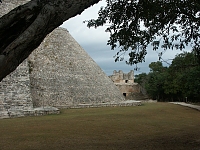
|
Looking northwest toward the north building of the NunneryThe Nunnery Quadrangle is made up of four separate buildings joined at the corners. All are long low one-story buildings with emphatic horizontality, made even more obvious by the use of Puuc ornament: plain lower walls with stone mosaic friezes carved in the upper register. Although it includes some eighty plus rooms, the purpose of the Nunnery is unknown. (It was clearly not a Nunnery, this name being given the structure by European conquerors.) | |
Nunnery, The East BuildingThe building is on a low platform and has five doorways into a complex of fourteen rooms. The Puuc frieze consists of triangular-shaped lattice patterns and Itzam-Ye (or Chac/Tloloc?) masks at the corners and middle of the frieze. |
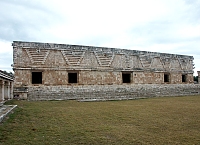
|
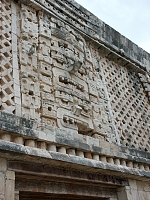
|

|
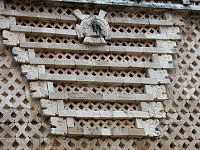
|
The lattice inverted triangles are divided by parallel double-headed serpents--the shortest at the bottom and the longest at the top. The owl sculpture at the top is associated with warfare and sacrifice in Mayan culture. |
Nunnery, The West BuildingFacing the East Building, this structure is similar--on a low platform but with seven doorways into the fourteen rooms. It is 59 yards long, seven yards longer than its opposite number--so the Quadrangle is not an exact square. |

|
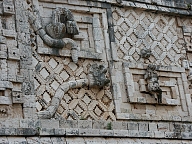
|
| The frieze here includes Maya huts, step and fret motifs, and mat grids. But the length of the frieze also includes two feathered serpents, complete with rattler tails and a man emerging from the snake mouth. Other human and animal figures are interspersed. | ||
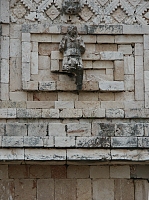
|
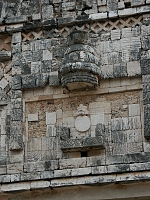
|
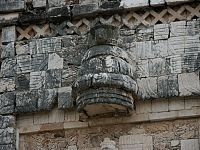
|
 Go to the Mexico Index.
Go to the Mexico Index. Click here to return to index of art historical sites.
Click here to return to index of art historical sites.
 Click here to return to index of artists and architects.
Click here to return to index of artists and architects.
 Click here to return to chronological index.
Click here to return to chronological index.
 Click here to see the home page of Bluffton College.
Click here to see the home page of Bluffton College.
